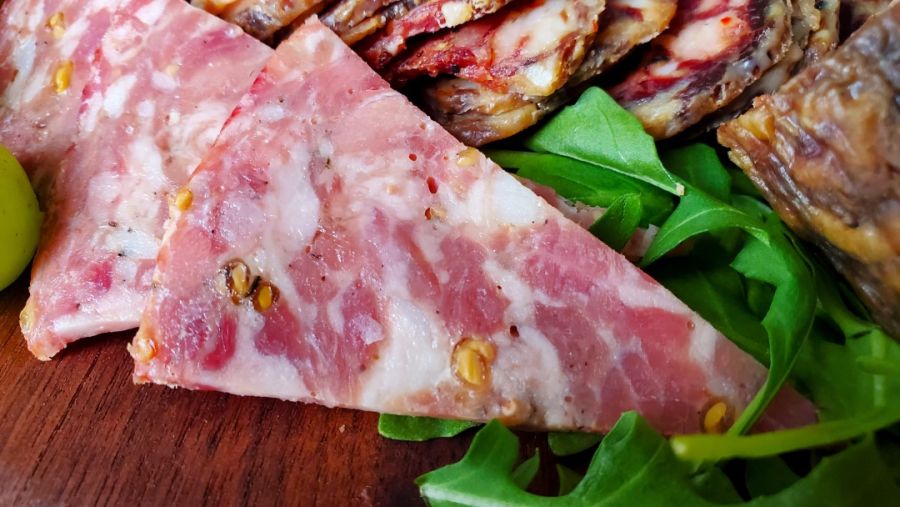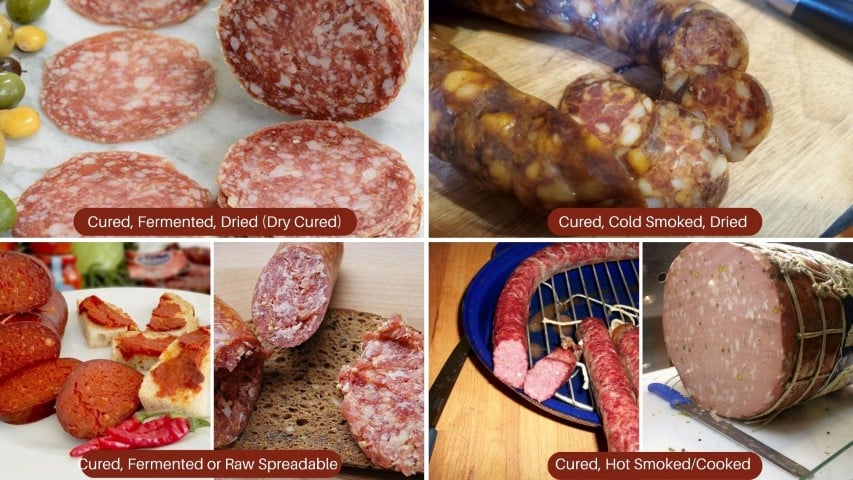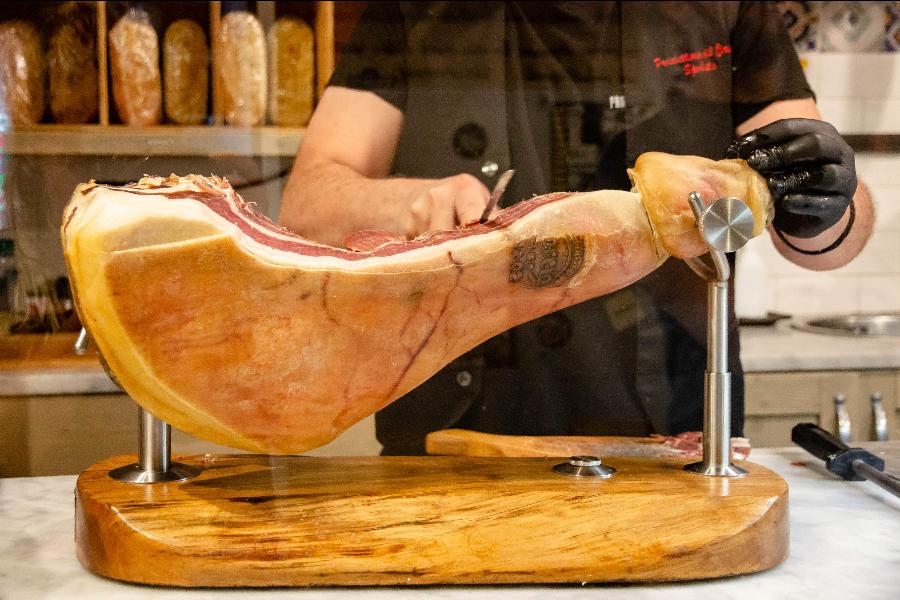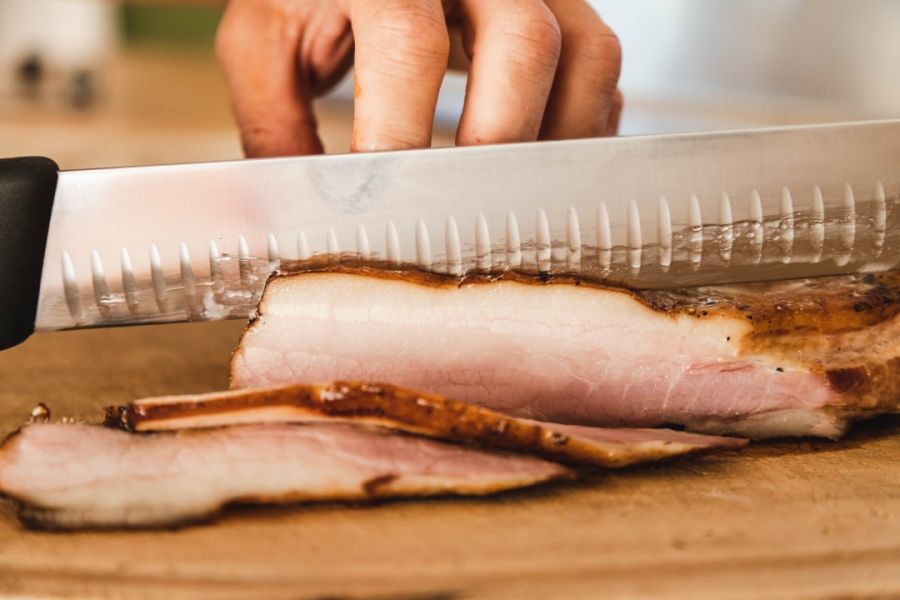Cured meats come in many different formats and types, so it can be hard to categorize some cured meats.
This article covers some of the nuances and confusion commonly asked around this website, which is focused on cured meats.
From my teaching, experiences, and practice across all aspects of the art and craft of cured meats, I will give you the most accurate information to a newcomer or inquisitive person.
I will also reference official sites so it won’t just be my knowledge.
Cured meat can be in several categories; all include salt, which is the curing process. Whole muscle and salami can be dry-cured types of meat like pancetta or prosciutto. Cured meats can also be cooked and smoked until the meat is at a safe-to-eat internal temperature such as pastrami or smoked ham.
Some confusion online is that nitrates are the aspect of curing since they are often labeled “pink curing salts” in the USA. This comes down to interpretation, however. You are curing meat with salt when not using nitrates/nitrites.
Cured meat can be two different main categories:
- Dry Cured or Wet Brined and Dried
- Cured and Cooked With or Without Smoke for Flavoring
The first category, salt, is used to preserve and flavor the meat before it is dried. Sometimes, it is also cold-smoked.
The second category is meat, which can be cured to hold moisture on the surface of meat-curing cooking and involves smoking.
This can also encourage drying the outside of the meat if the meat is to be cooked and hot smoked.
Examples include hot smoking with direct heat or even salt wet brining turkey before baking/roasting it.
As mentioned, cured and cooked.
Because there are so many other ways of eating and cooking meat that are not just baking or using indirect low temperature with smoke, such as low and slow smoking—an evolution from early European settlers to America.
You also get cured meats like salami cooked using steam inside a chamber.
Here is a picture of a ‘steamed’ salami where I worked and toured a small, passionate Salami factory in Indianapolis called Smoking Goose.

Another type of cured cooked meat is mortadella, an emulsified sausage with a smooth texture that is often simmered or steamed at a low cooking temperature.

The Salami cotto and steamed Mortadella are examples of salt curing, which is cooked also (In America, the commercial versions that aren’t pure in meat and spices are called bologna or baloney.
Not all cured meats (here is an article about which cured meats need refrigeration) are only salt-dry cured, then dried out.
Cured Meats
Now, we shall break down these categories of cured meats to gain helpful insight into how they are categorized and which you’ve probably tried already.
Curing Meat Always Involves Salt
Whether the cured meat(some cured meats are cooked, more on that here) is dried and preserved or cooked and possibly smoked, the curing always means there is salt involved, which performs a specific task beyond seasoning.
Salt can slow down the water activity inside the meat for the dry-cured preserved style. When the water activity slows down, the unwanted bacteria that can spoil meat find the environment inhospitable.
The process is often labeled as binding and diffusion inside the meat.
For Cotto-cooked salami and Mortadella above, salt is used to assist the process of extracting myosin from the meat. This allows the meat to be transformed in binding and texture.
Common Types of Cured Meats
Salt Dry Cured or Wet Brined and Dried (Includes Cold Smoked)

- Whole Muscle Dry Cured Meat
- Salami Dry-Cured Meat
- Dry Cured Bacon (Needs Cooking)
The outlier in the picture above to this category is the raw spreadable style mentioned, such as Mettwurst. These cured spreadable minced sausages often use salt, sometimes cold smoke, and acidification.
One of the most common and popular types of dry cured meats is Prosciutto de Parma, when made in Italy, where it has many regulatory protections that have to be a minimum of 12 months, which involves the salt curing phase, and then a careful drying phase.
You may have tried salamis before, but many variations are available worldwide.
Traditional Mediterranean dry-cured salami takes 3 to 10 months to make.
Some more mass-produced commercial salamis can be produced in only a few days through acidification rather than traditional drying techniques.
You’ll be familiar with salami such as Milano, Sweet Italian, Lap Chong, Pepperoni, or Felinoi. Generally speaking, they all have many variations in quality.
The larger scale production often degrades quality (often due to profiteering motivation over passion).
Small operators with passion often will have quality products in my experience.
How You Can Cook with Dry Cured Meats
Most of the dry cured meats that you see below in the list such as prosciutto, braesola, pancetta, and cullatello – are sliced wafer thin and enjoyed on a meeting cheese platter and antipasti or charcuterie board.
This is also due to the salt preservation amount; the thin slices balance the salty aspects.
The larger fat-to-meat ratio dry cured classic Italian meats, such as pancetta or guanciale (the classic for traditional carbonara) are often used for a base of rich flavor in classic Italian pasta.
Such as Spaghetti Carbonara and Bucatini all’Amatriciana
Another common way to use prosciutto or possibly pancetta when it is wafer-thin sliced is to wrap it around the cantaloupe, honeydew, or rock melon, as part of an appetizer or entrée.
The sweetness offsets the salty cured meat.

Cured Cooked/Hot Smoked
- Hot Smoked Salami
- Poached/Steamed Salami/Emulisifed Meats


Cooked and hot smoked (also if your interested I wrote about whether cured meats are keto) cured meat can come in many different forms, whether it’s whole muscle, type of cooked salami, or a cooked emulsified uniform textured sausage salami.
You can also put in this category hotdogs or frankfurters, which are emulsified sausages; emulsification, simply put, means water has been binded to the meat. It’s been mixed and ground to the point where the meat and fat are uniform.
Similarly but slightly different, a large mortadella sausage or salami is often sliced very thinly and can be 1 ft or 300 mm wide, like the large-diameter picture at the start of the article.
It’s a similar process to a hot dog with frankfurter, an emulsified cooked type of cured meat sausage, sometimes with smoke, either hot (whilst cooking) or cold, depending on the recipe.
Some large corporations use emulsified sausage, like hot dogs, to add ingredients that are not meat.
The goals are sometimes for holding water (more profitable), preserving (longer shelf life) or flavor enhancers (taste).
It’s easier to hide what is inside the emulsified sausage like a hot dog since it has a paste-smooth texture.
You’ll often find many additives, preservatives, and additional binding agents inside a hot dog.
Whilst, many Italian mortadella emulsified meats will only have meat, salt, and spices.
Preparing Cooked/Hot Smoked Cured Meats
Common ways cooked/hot smoked cured meat is used:
- Pastrami Sandwich: like the Reuben with Pastrami, with Rye Sourdough
- Hot Dogs: in a bun with tomato and mustard sauce or on a stick
- Ham and Cheese Sandwich: Slices of cured ham, such as Virginia ham or Black Forest ham, with cheese, lettuce, and often accompanied by mustard or mayonnaise.
- Mortadella Sandwich: with cheese and sometimes olives.
- Linguica Sandwich: Portuguese sausage, often served in a bun with onions, peppers, and various condiments.
- Kielbasa and Sauerkraut: Roasted kielbasa (Polish sausage) served with sauerkraut and sometimes mustard.
- Andouille Sausage Po’ Boy: A Louisiana-style sandwich made with spicy andouille sausage, often served with Creole mustard and coleslaw.
These are just a few examples of the thousands of ways cooked/hot smoked cured meats are used.
Popular Cured Meats and What They Are
Dry Cured:
| Cured Meat | Origin | Description |
|---|---|---|
| Black Forest Ham | Germany | Dry-cured ham, similar to prosciutto but with a distinct flavor from acorn-fed pigs, is more common than Ibérico |
| Prosciutto | Italy | Classic Dry-cured ham, usually sliced thin and enjoyed as a delicacy. Parma De Prosciutto ingredients – Salt and Pork Only |
| Chorizo | Spain and Portugal | Fermented sausage made from pork and flavored with paprika. Can be a fresh raw sausage (link to the sausage category on this site) to be cooked also |
| Dry Cured Salami | Italy | Various types of air-dried sausages, often made with beef and pork. ie. picante, milano, felino, soppressata (can be cooked ver. too) |
| Bresaola | Italy | Dry Cured, Air-dried beef, typically sliced thinly and served as an appetizer. |
| Capicola (Coppa) | Italy | Dry-cured Italian cold cut made from the upper neck, pork shoulder. |
| Jamón Serrano | Spain | A premium dry cured meat made from Iberian pigs, aged for exceptional flavor, specific diets, barley, chestnuts, olives, and acorns |
| Jamón Ibérico | Spain | Calabrian spreadable dry cured minced meat, very spicy, and soft. Pepperocinco chili from Calabria gives it a unique flavor. |
| Pancetta | Italy | Italian is typically used in pasta sauces and on charcuterie (did you know if charcuterie is gluten-free, I wrote about this in detail) boards. |
| Lukanka | Bulgaria | A dried, fermented sausage with a slightly sweet and tangy (I wrote in detail about the unique taste of salami here) flavor. |
| Nduja | Italy | Calabrian spreadable dry cured minced meat, very spicy and soft. Pepperocinco chili from Calabria gives it a unique flavor. |
Cooked/Hot Smoked:
| Cured Meat | Origin | Description |
|---|---|---|
| Pastrami | USA (Jewish) | Wet Cured/Brined and often smoked beef used in sandwiches. |
| Corned Beef (or other Meat) | Various | Wet Brined/Pickled, popular in sandwiches. Commercialized often. |
| Mortadella | Italy | Wet Brined/Pickled, popular in sandwiches. Commercialized often. |
| Linguiça | Portugal | A spicy, hot smoked sausage often used in Portuguese and Brazilian dishes. Many variations |
| Kielbasa | Poland | A type of hot smoked Polish sausage, often grilled or roasted. |
| Cervelat | Switzerland | A Swiss sausage made from a mixture of beef and pork. Emulsified like mortadella or frankfurters |
History of Cured Meat
After extensively studying history for other articles and books, I’ve seen the development of coarse techniques used tens of thousands of years ago.
For thousands of years prior, preservation was the main reason meat was cured with salt, to last longer through the cold months.
In Tropical and humid areas of the world, you do not find a history of salt curing, its often more focused on sun drying for preservation.
Through refinement during Roman times, dry-cured meats became more like the prosciutto (here are some prosciutto substitutes I wrote about) and dry-cured salami that we are familiar with.
History of Cured Meat – an article I wrote
Natural and Synthetic Nitrates
Many of these variations of cured meats have natural or synthetic nitrates; whether the nitrate is derived from a natural form like beetroot or celery, it still has the same effects.
“UnCured” Packaging Explained in the United States
If companies use ‘natural’ forms of nitrates, such as celery or beetroot powder, then
Some of the latest scientific research in the United Kingdom since 2018, has highlighted it is unnecessary to use nitrates.
The motivation for using them commercially has often been to speed up the curing time of the meat and change the pork color when cooked to a more appealing pink rather than the grey color that can sometimes be presented.
Essential and Most Popular Cured Meats
Prosciutto de Parma is the most widely known dry-cured meat
Curing is also picking or wet cure brining; one of the most well-known popular wet-cured meats is Pastrami, traditionally a curd beef meat.
The most popular cured meats from different continents of the world below:
- Europe:
- Prosciutto (Italy): A dry-cured ham, often sliced thin and enjoyed as an appetizer or in sandwiches.
- Dy Cured Chorizo (Spain): A spicy sausage made from pork, paprika, and garlic, often used in Spanish and Portuguese cuisine.
- Dry Cured Salami (Italy): A fermented and air-dried sausage that comes in various regional variations.
- South America:
- Cecina (Peru): Thinly sliced and salted dried meat, often made from beef or alpaca, served as a snack or appetizer.
- Asia:
- Biltong (South Africa): Air-dried and seasoned meat strips, similar to jerky.
- Lap Cheong (China): A Chinese sausage made from pork and seasonings, often used in stir-fried dishes or as a topping for rice.
- Himono (Japan): Wet Brine Cured and Dried Fish
- England:
- Bacon is a popular cured meat, often smoked – perfected in England, Needs Cooking. Originated from the Roman era.
Links to Official Sites on Meat Curing and Preservation
Here are links to official government departments relating to meat curing for technical and studying purposes.
USDA
National Centre for Home Food Preservation
American Meat Science Association
Comparing American & Europe Cured Meat
Centre for Food Safety – Hong Kong
How Long Will Cured Meat Stay Safe?
Dry Dry-cured meat is preserved like Proscuitto and tends to dry out more.
The meat I’ve stored and made, which is dry cured, has been vacuum-packed in a refrigerated environment. It has begun to deteriorate in quality after 3-4 years in the fridge.
Video Links to Dry-Cured Meat
Here is a video I produced that related to the category of dry-cured meats.
Other Cited and Referenced Resources:
https://en.wikipedia.org/wiki/Curing_(food_preservation)#cite_note-Doward-6

Tom Mueller
For decades, immersed in studying, working, learning, and teaching the craft of meat curing, sharing the passion and showcasing the world of charcuterie and smoked meat. Read More
